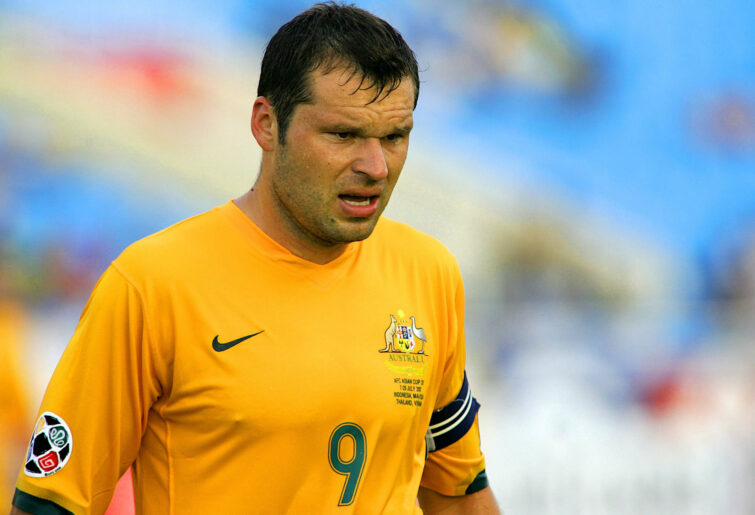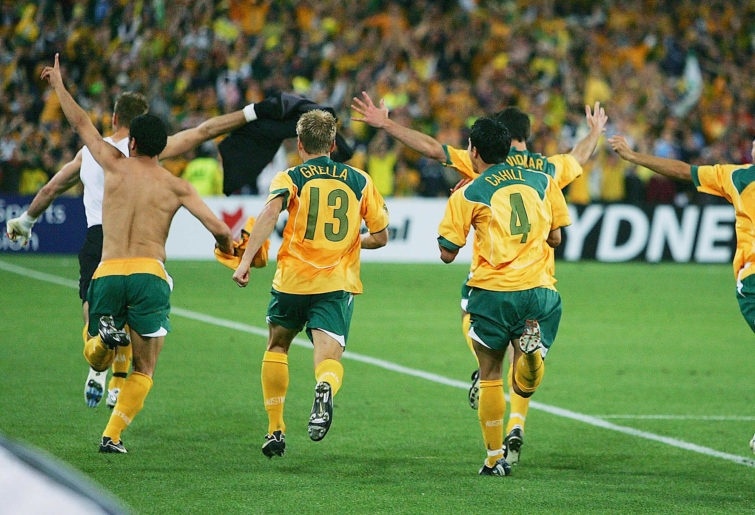Nicholas Stöckling
new author
Roar Rookie
I can still vividly recall when this infatuation began.
On a wet and windy night in Parramatta in February 1991, I was one of barely 8000 people who watched a depleted Czechoslovakia outclass a pedestrian Socceroos outfit in one of Eddie Thompson’s first games at the helm.
Having been mesmerised and enchanted by the previous year’s World Cup, waking up at ungodly hours to follow my adopted team West Germany to glory, I deeply yearned for a team of my own. The colour, excitement, tension and sheer passion of Italia ’90 could not have contrasted more starkly with the drab friendly I witnessed before me. As the rain fell, the echoes of the players’ remonstrations on the field broke the near silence in the stands.
Yet somehow, in some peculiar fashion, I felt a bond being forged. However, to imagine that the Socceroos would in the next two decades, be transformed into a team affectionately loved by the entire country, make the last 16 of the World Cup, and enter the top 20 football nations in the world, was beyond the wildest dreams of the few thousand who returned home damp that evening, after an unaspiring 2-0 loss.
While the Aussies of ’91 may not have possessed the genius of my father’s team, the world champion West Germans, they had incredible heart and determination. The remnants of the ‘mad dog’ Socceroos shaped the tactics, with a direct, intimidating approach as vaunted by previous coach Frank Arok still on display.
Yet a revolution was undoubtedly occurring, and I recall fleeting examples of the metamorphous from the bruising British approach, to a more cultured style of play. A young Ned Zelic made his debut that day, as did the Marconi midfielder Paul Okon. Both these two would go on to lead distinguished careers in the top leagues of Europe, and both became part of the ‘ golden generation’ that would forever change the face of football in this country.
This revolution would gain momentum in the World Youth Championships from 91 to 97 and every avid Socceroo supporter will tell you that prior to the glory of Kaiserslautern or the desperate heroics in South Africa against the classy Serbs, these tournaments were where football fans in this country sensed the tide may be turning. This was where we got our international fix.
The World Youth Championships of 1991 in Portugal was when my love for the green and gold reached a new level. Watching the Young Socceroos take on the hosts Portugal at Lisbon’s Estadio de Luz in front of 120,000, with Les Murray’s crackling commentary constantly drowned out by the frenzied crowd, remains a clear, nostalgia laden memory.
During this pulsating semi-final a resilient defence containing Popovic, Okon, and Muscat matched the future global superstars Rui Costa, Joao Pinto and Luis Figo.
Mark Bosnich showed a glimpse into the future, as he confirmed his status as one of the brightest goalkeeping prospects with an epic display.

Mandatory Credit: Ben Radford /Allsport
This new generation was clearly ready to take the next step and I was gripped at the prospect. However a decade was to pass until the dream became reality.
But how did the national team begin to implant itself into the Australian sporting psyche?
The seismic shift in the general Australian public’s attitude to football in this country has been viewed by many to have begun with the appointment of Frank Arok as national team coach. The Yugoslav possessed a driving ambition and a tenacious spirit which he injected into all his teams.
While never witnessing Arok’s team firsthand, the ‘club Socceroo’ philosophy was clearly still a unifying force in the early 1990s. Many Australian football experts such as Johnny Warren and Les Murray believed that Arok saw the job as they did; it was a mission to spread the world game and place it at the forefront of the Australian sporting consciousness.
The gripping encounters with Israel and Scotland in the ’86 campaign raised general awareness of the national team to new heights, as did the Bicentennial Cup which saw perhaps the greatest victory up to that point, a 4-1 demolition of Argentina. Yet in both World Cup campaigns under Arok, the Socceroos fell agonisingly short.
Outclassed by a Souneess-led Scotland in ’86, and felled by a shock loss to New Zealand in ’90. The desire and enthusiasm was undoubtedly there, but the technical ability of the Aussie allsorts was still a way off World Cup level.
The allure of Italia ’90 provided an operatic theme for my enchantment with this beguiling and mesmerising game. My wall was adorned with cut-outs from every qualified country. The USSR, Cameroon, Argentina, Brazil, Romania and of course West Germany covered every possible patch of wall space, blu-tack and scissors being my tools of trade.
The nations of the world taught me geography and fascinated me with their obscure, alluring and often unpronounceable names. Michaleachenko, Raducioui, Valderamma became real people providing me with an insight into foreign worlds.
The Germans, however, were my central source of imagination. Klinsmann, Voller, Mathaus and Littbarski dominated my thoughts and permeated my dreams. My headers were glanced in the gate corner a la Klinsmann against Holland, the words of Martin Tyler were the soundtrack to my “marauding Mathaus runs“ in the backyard.
While I was not entirely oblivious to the local football landscape, as my father and I often ventured to Brandon Park to watch the Wollongong Wolves take on the Melbourne Knights or West Adelaide Sharks, the passion, fervour and sense of grandeur I had just witnessed in the early hours of the morning was sorely lacking.
Soccerroo outings became the means by which I could briefly feel a connection with the fanatical supporters I saw every Saturday and Sunday on SBS. Mark Viduka has stated that the Italian soccer hour that was shown on Sunday mornings was a source of inspiration. This is undoubtedly true for me also.

(Photo by Koji Watanabe/Getty Images)
While my absorbing attraction to the football magic I witnessed every weekend did not lead to my playing in those very stadiums, it did succeed in heightening my obsession to that of a football zealot.
My infatuation with Germany began to recede as the Australian national team began to lift itself out of mediocrity and challenge far more illustrious international opposition. Perched up high in the stands with my father against England and running on the pitch against Sweden captivated my imagination, I began to dream that I was at the San Siro or Old Trafford. Yet the transformation into a fully fledged football culture was nowhere near complete.
The qualification campaign for the 1994 World Cup in the USA was to become an integral stepping stone in the rise of Australian football. Frank Farina, Mehmet Durakovic and a debuting Mark Schwarzer became figures to rival the European superstars in my reckoning after saving Australia from the abyss against Canada.
My hands were aching from slapping the sideboards and my throat hoarse as I roared on an improbable penalty shoot victory at a half-filled Sydney Football Stadium.
It was, however, the arrival of the greatest player on Earth that truly fused my passion for the world game with the fortunes of the Soccerroos. Argentina versus Australia on November, 17 1993 is for many Soccerroo fans a seminal date. For my 12-year-old eyes it represented a coming together of the glamour and life-or-death fanaticism that football abroad encapsulated and my developing kinship with the national team.
Sitting behind the goal transfixed, I can still see Maradona skip past a defender, before being tackled, turn back onto his wondrous left foot and ping the ball on to the head of Abel Balbo. Too good.
How were we supposed to compete with el Diego?
Yet the response was almost immediate. The tenacity of the mongrel Socceroos was now combined with elegance, as dogged hassling in the Argentinean front third eventually resulted in Zelic, the epitome of this new sophistication, playing a sublime through ball. The Vidmars did the rest.
The stadium erupted with a noise so raucous it felt as if the very foundations moved. The sheer volume of noise was unlike anything I have heard before or experienced since.
We were not going to be overrun, or outclassed. Not by Batistuta, not even by Maradona.
Watching the return leg from Buenos Aries with more hope than expectation, the match highlighted the bravery of this group of men, some of whom were part-timers.
In scenes reminiscent of the ’78 World Cup, confetti flooded the pitch at the teams entered, the noise crackling the microphone every time La Albiceleste went forward. A Batistuta cross, cruelly deflected in off the bar, was the difference between the World Cup finalists, who possessed the incredible genius of Diego Maradona, and my brave Socceroos. We were getting closer and my bond with the green and gold was sealed.
However, far more anguish awaited, leading many to believe the national team was cursed.
Yet the sheer agony of the MCG in ’97 or false dawn of Montevideo in 2001, are in my mind mere foils for the unbridled ecstasy that was experienced in 2005.

(Photo by Cameron Spencer/Getty Images)
Watching Schwarzer chase John Aloisi after his decisive penalty, shirt in hand spinning above his head, lost in the uncontrollable celebration that only football can bring, I sat silent, unable to digest what I had just witnessed.
People around me heaved forward, roaring collectively, embracing those they had never met.
As ‘Down Under’ began to reverberate around the stadium, a sign of the mainstream path the national team was now on, I caught eye contact with a middle-aged man a few rows in front of me. He too was quiet, overcome with emotion, his eyes occasionally closing in an attempt to breathe in the moment.
He smiled at me in a knowing manner. Both of us clearly felt an attachment to this team that had strengthened with age. Perhaps he too had sat in near empty stadiums dreaming of the passion of foreign football cultures. Maybe he also had felt the pain of every failing as deeply as I had.
What was clear now was that the Socceroos trajectory had taken a sharp turn upward and we were both going to savour every moment.